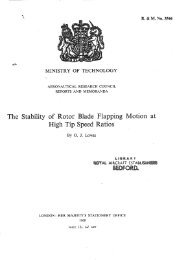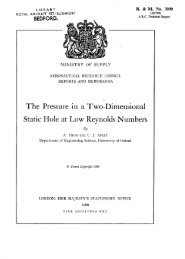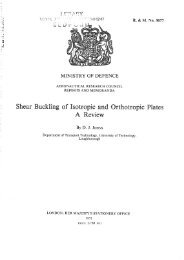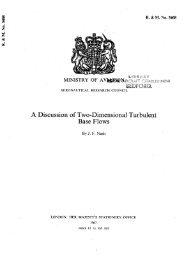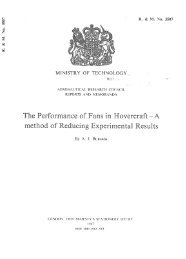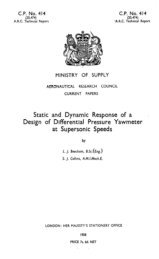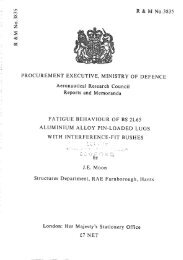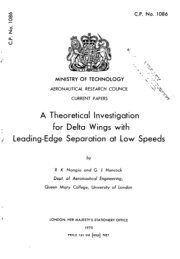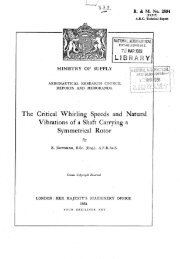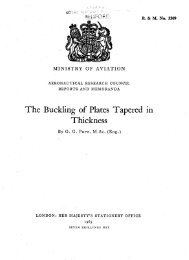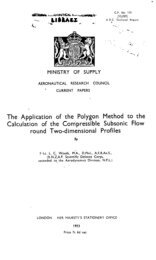The Influence of Surface Waves on the Stability of a ... - aerade
The Influence of Surface Waves on the Stability of a ... - aerade
The Influence of Surface Waves on the Stability of a ... - aerade
You also want an ePaper? Increase the reach of your titles
YUMPU automatically turns print PDFs into web optimized ePapers that Google loves.
1 Introducti<strong>on</strong><br />
<str<strong>on</strong>g>The</str<strong>on</strong>g> minimum sucti<strong>on</strong> quentlties required to preserve lennnar flow<br />
in <strong>the</strong> boundary layer <strong>on</strong> an aer<str<strong>on</strong>g>of</str<strong>on</strong>g>oil are calculated from stability <strong>the</strong>ory<br />
m. which It is assumed that <strong>the</strong> surface is aerodynamically clean. HoWever<br />
it has not yet been possible to obtain a porous surface entirely satisfying<br />
this c<strong>on</strong>ati<strong>on</strong>, and it seems probable that under producti<strong>on</strong> end flight<br />
c<strong>on</strong>diti<strong>on</strong>s <strong>the</strong> presence <str<strong>on</strong>g>of</str<strong>on</strong>g> shallow l<strong>on</strong>gitudinal waves and <str<strong>on</strong>g>of</str<strong>on</strong>g> smell<br />
excrescences mill be unavoidable. Such surface imperfecti<strong>on</strong>s are known<br />
to have a destabilising effect <strong>on</strong> -<strong>the</strong> boundary layer, and it is important<br />
to have some estimate <str<strong>on</strong>g>of</str<strong>on</strong>g> <strong>the</strong> penalty in increased sucti<strong>on</strong> which is likely<br />
to be associated with <strong>the</strong>m.<br />
<str<strong>on</strong>g>The</str<strong>on</strong>g> effect <str<strong>on</strong>g>of</str<strong>on</strong>g> protuberances is discussed in a paper pesented to<br />
<strong>the</strong> E&mdary Layer C<strong>on</strong>trol C<strong>on</strong>unittee by P.R. C&en and X!ss Klsnfer', and<br />
<strong>the</strong> present paper c<strong>on</strong>tains calculati<strong>on</strong>s <str<strong>on</strong>g>of</str<strong>on</strong>g> <strong>the</strong> effect <str<strong>on</strong>g>of</str<strong>on</strong>g> surface waviness.<br />
To avoid ma<strong>the</strong>matical<br />
flow over a sinusoidal<br />
complexity we c<strong>on</strong>sider <strong>the</strong> hypo<strong>the</strong>tical<br />
27tx<br />
surface <str<strong>on</strong>g>of</str<strong>on</strong>g> height y = h cos L , with<br />
case <str<strong>on</strong>g>of</str<strong>on</strong>g><br />
sucti<strong>on</strong><br />
c<strong>on</strong>diti<strong>on</strong>s asymptotic in <strong>the</strong> sense that <strong>the</strong> boundary layer thickness and<br />
shape is <strong>the</strong> same at corresp<strong>on</strong>ding points in successive waves. If <strong>the</strong><br />
height : wavelength ratio g were large enough such c<strong>on</strong>diti<strong>on</strong>s would be<br />
impossible, but for practical values <str<strong>on</strong>g>of</str<strong>on</strong>g> r<br />
h<br />
, <str<strong>on</strong>g>of</str<strong>on</strong>g> <strong>the</strong> order <str<strong>on</strong>g>of</str<strong>on</strong>g><br />
-3<br />
10 , a<br />
linearised soluti<strong>on</strong> may be obtained by excluding squares <str<strong>on</strong>g>of</str<strong>on</strong>g> 1? L<br />
0<br />
. <str<strong>on</strong>g>The</str<strong>on</strong>g><br />
pIX!CeSS<br />
outlined<br />
is thus justifiable<br />
in <strong>the</strong> man part<br />
a posteriori.<br />
<str<strong>on</strong>g>of</str<strong>on</strong>g> <strong>the</strong> paper,<br />
<str<strong>on</strong>g>The</str<strong>on</strong>g> method and results<br />
<strong>the</strong> ma<strong>the</strong>matical details<br />
are<br />
being<br />
given in <strong>the</strong> Appendices.<br />
A possible objecti<strong>on</strong> to <strong>the</strong> applicability <str<strong>on</strong>g>of</str<strong>on</strong>g> <strong>the</strong> results is that<br />
aAqmptoti2 c<strong>on</strong>diti<strong>on</strong>s are not to be expected <strong>on</strong> a wing because less<br />
sucti<strong>on</strong> is required for stability than is necessary to produce <strong>the</strong>m, and<br />
because <strong>the</strong> boundary layer increases in thickness under <strong>the</strong> influence <str<strong>on</strong>g>of</str<strong>on</strong>g><br />
pressure gradients. However <strong>the</strong> calculati<strong>on</strong>s have been designed to show<br />
<strong>the</strong> peroentage increase in sucti<strong>on</strong> necess‘zry when waves are present to<br />
preserve <strong>the</strong> stability <str<strong>on</strong>g>of</str<strong>on</strong>g> <strong>the</strong> worst pr<str<strong>on</strong>g>of</str<strong>on</strong>g>ile which occurs at <strong>the</strong> same<br />
level as for an aerodynemxcally flat surface; and it may be c<strong>on</strong>jectured<br />
that this percentage is relatively independent <str<strong>on</strong>g>of</str<strong>on</strong>g> <strong>the</strong> basic pr<str<strong>on</strong>g>of</str<strong>on</strong>g>ile shape.<br />
In general different relative increases in sucti<strong>on</strong> will be necessary at<br />
different chordwise points, since <strong>the</strong> increase required depends <strong>on</strong> <strong>the</strong><br />
amount already used, which follows a definite chordwise distributi<strong>on</strong><br />
(increasing c<strong>on</strong>siderably when <strong>the</strong> adverse pressure gradient is reached).<br />
2 <strong>Stability</strong> <strong>the</strong>ory for parallel flows<br />
<str<strong>on</strong>g>The</str<strong>on</strong>g> ma<strong>the</strong>matical <strong>the</strong>ory <str<strong>on</strong>g>of</str<strong>on</strong>g> stability as developed by Lin*<br />
relates to parallel flows with n<strong>on</strong>-dimensi<strong>on</strong>al velocity pr<str<strong>on</strong>g>of</str<strong>on</strong>g>iles<br />
and o<strong>the</strong>rs<br />
2 u (Y), a-d<br />
c<strong>on</strong>siders <strong>the</strong> variati<strong>on</strong> in <strong>the</strong> x-directi<strong>on</strong> <str<strong>on</strong>g>of</str<strong>on</strong>g> <strong>the</strong> energy <str<strong>on</strong>g>of</str<strong>on</strong>g> disturbances<br />
with wave nwibers e [= 2&avelength].<br />
stability curve in <strong>the</strong> (a, Rh,) plane.<br />
For eaoh pr<str<strong>on</strong>g>of</str<strong>on</strong>g>ile <strong>the</strong>re is a neutral<br />
Disturbances whose coordinates lie<br />
within <strong>the</strong> curve till be amplified and lead eve~tudly to transiti<strong>on</strong>; all<br />
o<strong>the</strong>rs will be damped. <str<strong>on</strong>g>The</str<strong>on</strong>g> curve is typically <str<strong>on</strong>g>of</str<strong>on</strong>g> <strong>the</strong> shape shown in Fig.1.<br />
<str<strong>on</strong>g>The</str<strong>on</strong>g> lower branch tends asymptoticelly to a = 0 as R& -tm;<strong>the</strong> upper may<br />
tend to 0 or to a Sinite value, depending <strong>on</strong> <strong>the</strong> pr<str<strong>on</strong>g>of</str<strong>on</strong>g>ile shape.<br />
<str<strong>on</strong>g>The</str<strong>on</strong>g> m&mum Reynolds number below which all disturbances are aamped<br />
iskncwnas (R6~~)critxal* A measure <str<strong>on</strong>g>of</str<strong>on</strong>g> <strong>the</strong> instability <str<strong>on</strong>g>of</str<strong>on</strong>g> a particular<br />
Pr<str<strong>on</strong>g>of</str<strong>on</strong>g>ile shape at a given Reynolds number is provided by <strong>the</strong> area included<br />
between its neutral stability cwve and <strong>the</strong> ordinate IJI questi<strong>on</strong> - e.g. by<br />
<strong>the</strong> shaded area in <strong>the</strong> diagram<br />
'1 -



